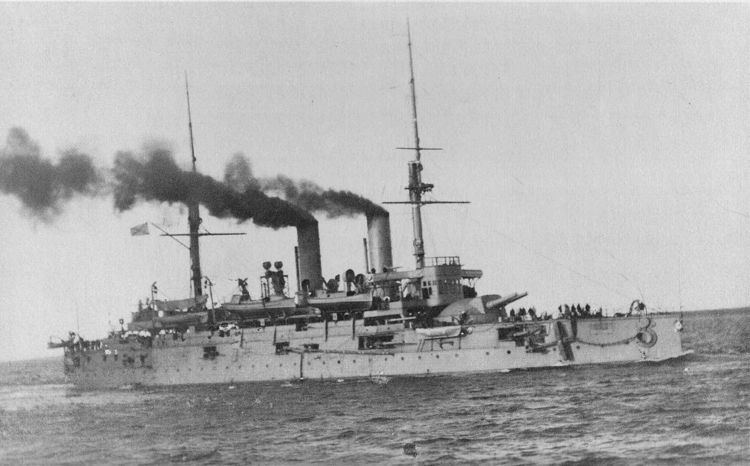Name Imperator Aleksandr II Laid down 12 July 1885 Out of service 21 May 1921 Launched 13 July 1887 Beam 20 m | Commissioned June 1891 Construction started 12 July 1885 Length 102 m | |
 | ||
Renamed Zarya Svobody about 9 May 1917 Builders Admiralty Shipyard, Saint Petersburg | ||
Imperator Aleksandr II (Russian: Император Александр II) was a battleship built for the Imperial Russian Navy in the 1880s. She was an artillery training ship assigned to the Baltic Fleet by the time of the Russo-Japanese War of 1905 and was not sent to the Pacific as was most of the rest of the Baltic Fleet. She was inactive at Kronstadt during World War I, but her crew was active in the revolutionary movement. She was turned over to the Kronstadt port authority on 21 April 1921 before she was sold for scrap on 22 August 1922. She was towed to Germany during the autumn of 1922, but was not stricken from the Navy List until 21 November 1925.
Contents
Description
Imperator Aleksandr II was named after the Emperor Alexander II of Russia. She was built by the New Admiralty Yard at Saint Petersburg. She was laid down in June 1885, launched in July 1887, and completed in June 1891, although her trials lasted until the spring of 1892.
She was 334 feet (101.8 m) long at the waterline and 346 feet 6 inches (105.6 m) long overall. She had a beam of 66 feet 11 inches (20.40 m) and a draft of 25 feet 9 inches (7.85 m). She displaced 9,244 long tons (9,392 t) at load, over 800 long tons (813 t) more than her designed displacement of 8,440 long tons (8,575 t).
Imperator Aleksandr II had two three-cylinder vertical compound steam engines driving 17-foot (5.2 m) screw propellers. Twelve cylindrical boilers provided steam to the engines. Her engines were built by Baltic Works and had a total designed output of 8,500 indicated horsepower (6,338 kW). On trials, the powerplant produced 8,289 ihp (6,181 kW), and a top speed of 15.27 knots (28.28 km/h; 17.57 mph). She carried 967 long tons (983 t) of coal that provided a range of 4,400 nautical miles (8,100 km) at a speed of 8 knots (15 km/h; 9.2 mph) and 1,770 nautical miles (3,280 km) at a speed of 15 knots (28 km/h; 17 mph).
The main armament of the Imperator Aleksandr II-class ships was a pair of 12-inch (305 mm) Obukhov Model 1877 30-calibre guns mounted in a twin barbette mount forward. The four 9-inch (229 mm) Obukhov Model 1877 35-calibre guns were on center-pivot mounts in casemates at the corners of the citadel, the hull being recessed to increase their arcs of fire ahead or behind. The eight 6-inch (152 mm) Model 1877 35-calibre guns were mounted on broadside pivot mounts. Four were fitted between the 9-inch guns and could traverse a total of 100°. The others were mounted at each end of the ship where they could fire directly ahead or astern. The ten 47-millimetre (1.9 in) Hotchkiss revolving cannon were mounted in hull embrasures of the ship, between the nine and six-inch guns to defend against torpedo boats. Four 37-millimetre (1.5 in) Hotchkiss revolving cannon were mounted in each fighting top. Imperator Aleksandr II carried five above-water 15-inch (381 mm) torpedo tubes. Two in the bow, one on each side of the stempost, one tube on each broadside and a tube in the stern. Smaller 14-inch (356 mm) torpedo tubes could be mounted in four of the ship's cutters. 36 mines could also be carried.
History
Imperator Aleksandr II served in the Baltic Fleet and represented Russia, along with the cruiser Rurik, at the opening of the Kiel Canal in June 1895. She ran aground in Vyborg Bay later that year, but sustained little damage. She joined the Mediterranean Squadron in August 1896 and supported Russian interests during the Cretan Revolt of 1897. She returned to Kronstadt in September 1901. She was reboilered in December 1903 and modified in 1904 to serve as an artillery school ship. Her crew refused to suppress the mutinous garrison of Fort Konstantin defending Kronstadt in August 1906. She was assigned to the Artillery Training Detachment in 1907. She spent most of World War I in Kronstadt where her crew was active in the revolutionary movement. She was renamed Zarya Svobody (Заря Свободы—Dawn of Freedom) in May 1917. She was turned over to the Kronstadt port authority on 21 April 1921 before she was sold for scrap on 22 August 1922. She was towed to Germany during the autumn of 1922, but was not stricken from the Navy List until 21 November 1925.
Conway's says that she was reconstructed in France between 1902 and 1904, with her torpedo tubes removed and her six and nine-inch guns exchanged for five 8-inch (200 mm) 45 calibre guns and eight six-inch 45 calibre guns. Her revolver cannon were also exchanged for ten three-pounder guns. Arbazov confirms that the torpedo tubes were removed and says that she had her nine-inch guns replaced by five 8-inch, the fifth being placed at the stern, the old six-inch guns were exchanged for newer, more powerful models, and four 47-mm and four 120-mm guns were added on the upper deck, presumably replacing the old revolver cannon.
